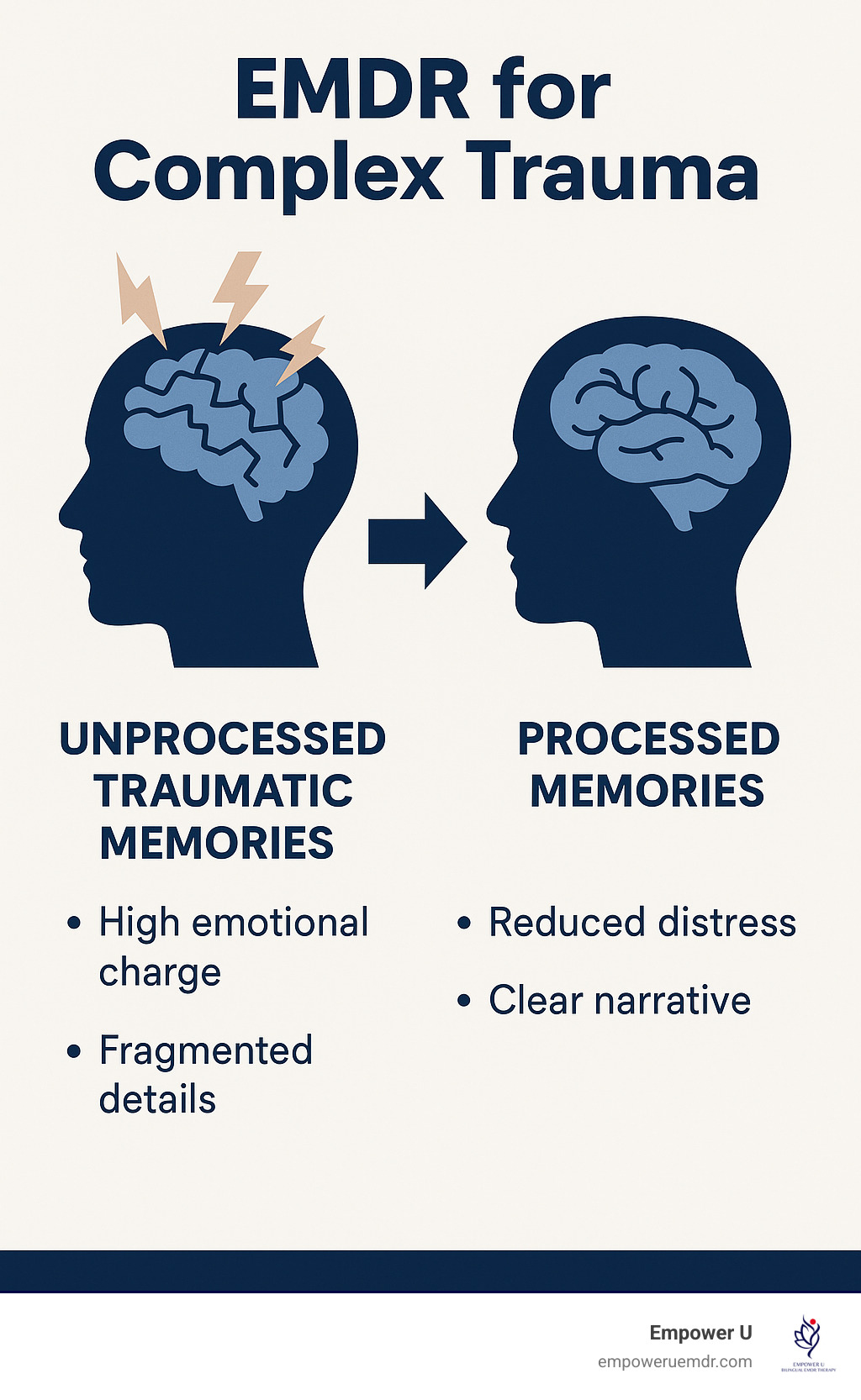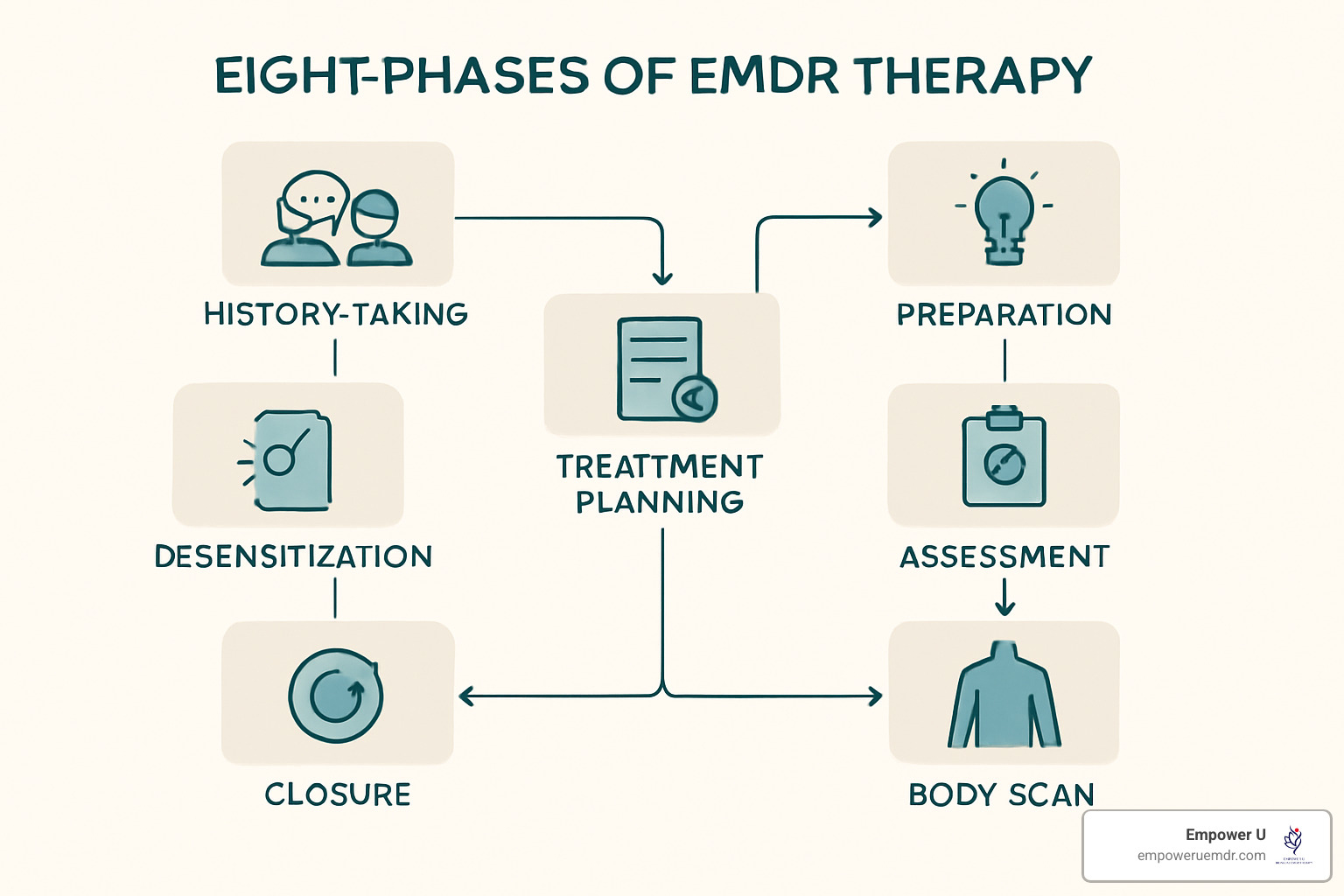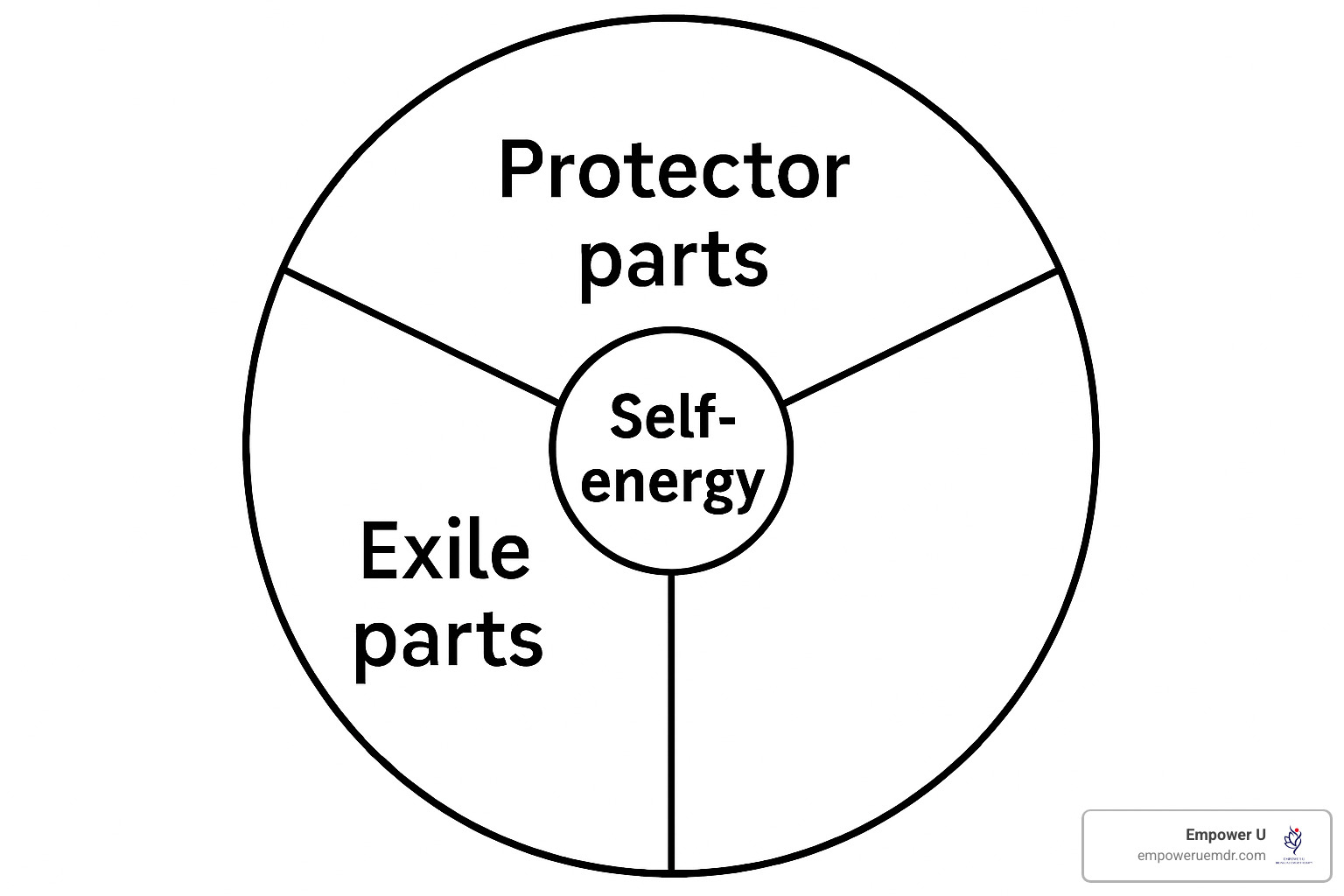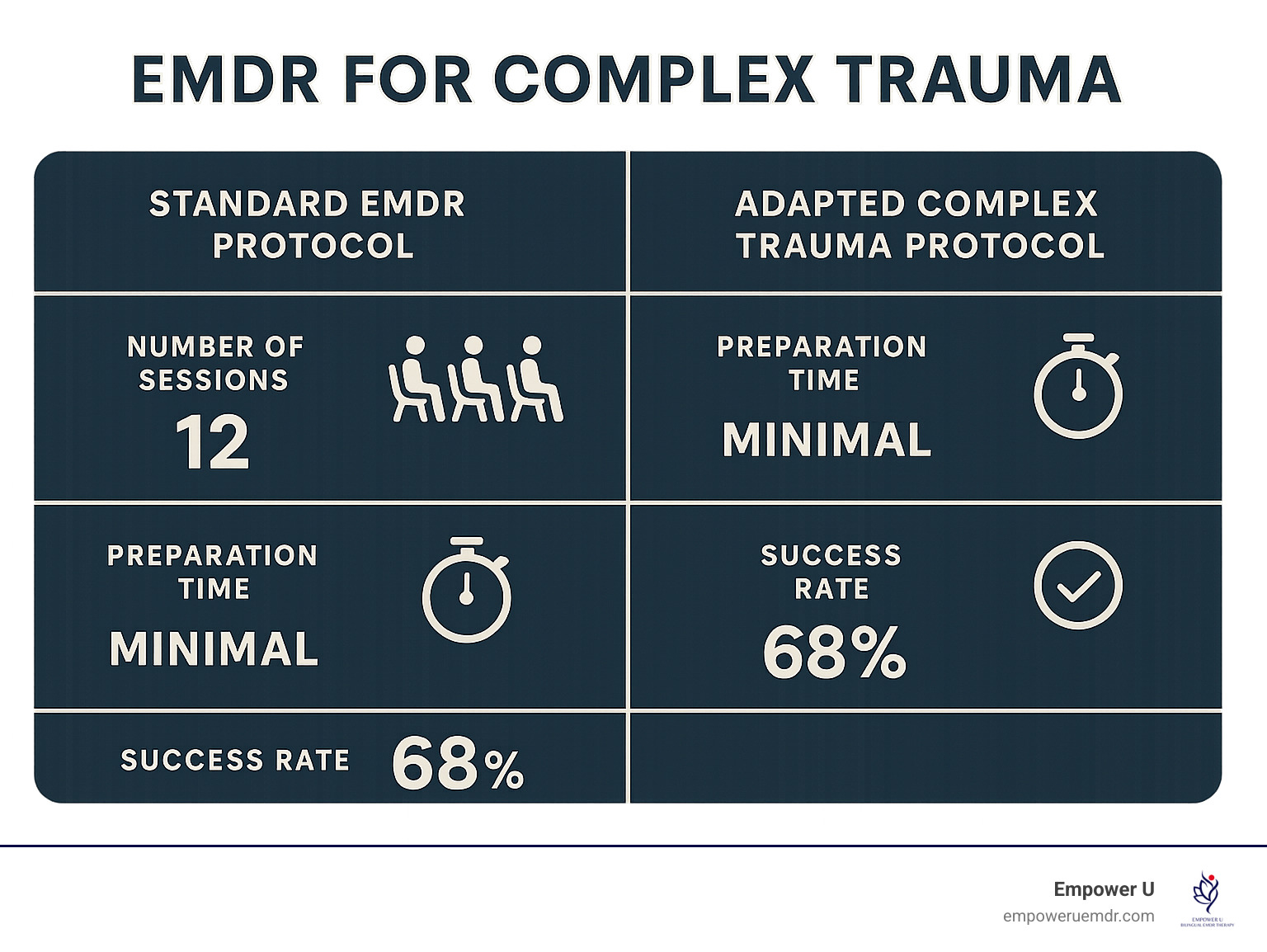Complex Trauma Meets Its Match—EMDR Explained
Understanding Complex Trauma and Why EMDR Offers Hope

EMDR for complex trauma is a specialized therapeutic approach that helps people heal from prolonged, repeated traumatic experiences through an eight-phase process using bilateral stimulation to reprocess stuck memories and beliefs.
Quick Overview: EMDR for Complex Trauma
- What it treats: Complex PTSD, developmental trauma, attachment wounds, and transgenerational trauma patterns
- How it works: Uses eye movements or tapping while recalling memories to help the brain process trauma naturally
- Key difference: Requires extended preparation phases and slower pacing compared to single-incident trauma treatment
- Timeline: Typically 12+ sessions with emphasis on safety and stabilization before memory processing
- Effectiveness: Research shows large effect sizes, with 2017 studies demonstrating significant symptom reduction in complex trauma cases
Living with complex trauma can feel like carrying an invisible weight that no one else seems to understand. Unlike single traumatic events, complex trauma stems from prolonged exposure to harmful experiences—often during childhood or within family systems. For many first-generation Americans and immigrants, this includes navigating cultural conflicts, family expectations, and identity struggles that create lasting emotional wounds.
The good news? EMDR therapy has shown remarkable success in treating complex trauma, though it requires careful adaptation. Research consistently demonstrates that EMDR can be highly effective for complex PTSD, with studies showing significant symptom reduction when proper pacing and preparation are used.
I'm Cristina Deneve, a bilingual EMDR-certified therapist who specializes in helping adult children of immigrants heal from transgenerational trauma and cultural identity conflicts. My own journey from engineering to therapy, combined with my experience navigating bicultural challenges, helps me understand how EMDR for complex trauma can be adapted to honor both your cultural background and your healing needs.

How EMDR Works: Rewiring Traumatic Memory
Imagine your brain as having its own natural healing system—much like how your body knows how to heal a cut. EMDR for complex trauma activates this system so stuck memories can finally be processed. When trauma happens repeatedly, memories are stored with their original emotions and body sensations. EMDR helps file them in the right place.
Bilateral stimulation—eye movements, alternating taps, or tones—creates dual attention: part of you stays grounded in my office, the other part visits the memory. This keeps the experience tolerable while your brain does the heavy lifting. A classic study on eye-movements and distress found the technique reduces emotional intensity, similar to how REM sleep processes daily events.
The Adaptive Information Processing Model
The AIP model says your brain is wired to integrate experiences and move on. When chronic trauma overwhelms this system, memories remain in isolated "pockets" that still fire off present-day distress. EMDR removes the block so natural healing resumes.
Think of it this way: when you experience something difficult but manageable, your brain naturally processes it during sleep and daily activities. You wake up the next day with the memory intact but without the overwhelming emotional charge. However, when trauma is too intense or happens repeatedly—especially during childhood—this natural processing system gets overwhelmed and shuts down.
These unprocessed memories become like files saved in the wrong folder on your computer. Every time something in your present life resembles the original trauma, your brain pulls up the old file with all its original emotions, body sensations, and beliefs intact. This is why a critical comment from your boss might trigger the same shame you felt as a child, or why certain smells or sounds can instantly transport you back to a difficult time.
Bilateral Stimulation & Working-Memory Taxation
Quick, rhythmic eye movements appear to tax working memory just enough that the traumatic scene loses vividness. Think of trying to solve a math problem while humming—there's only so much bandwidth. This slight overload makes it easier for the brain to "re-save" the memory with a lower emotional charge.
The bilateral stimulation mimics what happens naturally during REM sleep, when your eyes move back and forth as your brain processes the day's experiences. Research suggests this cross-lateral brain activation helps integrate information between the brain's hemispheres, allowing traumatic memories to be properly filed away as "past" rather than "present danger."
What you'll notice in session is a series of brief sets of eye movements, pauses to report what's coming up, and gentle guidance from me. Most clients describe it as watching a movie of their past rather than being dragged back into it. The bilateral stimulation creates enough distance that you can observe the memory without being overwhelmed by it, allowing your brain's natural healing wisdom to take over.
Complex Trauma Unpacked: Beyond Single-Incident PTSD
Most people picture trauma as one shocking event, but many first- and second-generation Americans live with a slow accumulation of stress: childhood criticism, cultural invalidation, family secrecy, and discrimination. Over time this becomes Complex PTSD (C-PTSD), now recognized in the ICD-11.
Traditional PTSD includes re-experiencing, avoidance, and hyper-arousal. C-PTSD adds three more problems:
- Emotional dysregulation (all-or-nothing feelings)
- Negative self-concept ("I'm broken")
- Interpersonal problems (difficulty trusting or feeling close)
Understanding the Complexity of Repeated Trauma
Complex trauma typically develops from prolonged, repeated exposure to traumatic events, especially when they occur during childhood or within caregiving relationships. Unlike a single traumatic incident—such as a car accident or natural disaster—complex trauma involves ongoing situations where escape feels impossible or where the source of trauma is also the source of care and protection.
For many immigrants and their children, complex trauma can include experiences like:
- Chronic family conflict around cultural expectations and individual desires
- Discrimination and microaggressions that accumulate over time
- Parentification, where children take on adult responsibilities to help family survive
- Cultural identity confusion and feeling like you don't fully belong anywhere
- Intergenerational trauma passed down through family stories, behaviors, and unexpressed grief
- Economic instability and the chronic stress of financial survival
These experiences create what trauma specialists call "developmental trauma"—trauma that occurs during critical periods of brain and identity development, shaping how you see yourself, others, and the world.
Developmental & Transgenerational Trauma in Immigrant Families
Immigrant households often juggle individual trauma (war, migration risks) and the "invisible trauma" of acculturation—straddling two cultures, code-switching, and feeling responsible for family dreams. Unprocessed pain can pass from one generation to the next, creating anxiety or shame that seems to appear "out of nowhere."
Transgenerational trauma occurs when the emotional and psychological effects of trauma are passed from one generation to the next. This can happen through direct storytelling, family dynamics, parenting styles, and even epigenetic changes that affect how genes are expressed. You might find yourself struggling with anxiety, depression, or relationship difficulties that seem disproportionate to your own life experiences—this could be your nervous system responding to trauma that originated in previous generations.
In immigrant families, this often manifests as:
- Hypervigilance around safety and security, even in safe environments
- Perfectionism and intense pressure to succeed as a way to justify family sacrifices
- Difficulty expressing emotions or needs, especially if they conflict with family expectations
- Survivor guilt about having opportunities that previous generations didn't have
- Identity fragmentation from trying to honor family culture while adapting to dominant culture
Because complex trauma lives in a web of memories, beliefs, and body sensations, treatment must do more than target single flashbacks. EMDR for complex trauma shines here because it can address clusters of related experiences while honoring cultural context.
EMDR for Complex Trauma—Eight-Phase Guide
The eight EMDR phases parallel Judith Herman’s stages of recovery—safety, processing, reconnection—but they unfold more slowly for complex trauma.

Phase 1: History & Treatment Planning
We build a life-span timeline to spot patterns and "keystone" memories whose healing could lighten many others. Cultural and family history guide which targets we choose first.
Phase 2: Preparation & Stabilization
For complex trauma, we may spend weeks here, expanding your window of tolerance with breathing, grounding, and Resource Development & Installation (RDI). These tools become your safety net when processing begins.

Phases 3–6: Processing Traumatic Memories
We tackle memories in manageable slices—sometimes an image, sometimes a body sensation—using bilateral stimulation until distress drops and a more helpful belief installs (e.g., "I did the best I could").
Phases 7–8: Closure & Reevaluation
Every session ends with grounding and a check-in plan. At the next visit we confirm the target stayed calm and decide what’s next.
| Single-Incident EMDR | Complex Trauma EMDR |
|---|---|
| 1–2 prep sessions | 4–12+ prep sessions |
| Clear event focus | Patterns & beliefs |
| Quick processing | Titrated pace |
| 6–12 total sessions | 20+ sessions common |
Customizing EMDR: Dissociation, Emotional Regulation & Cultural Safety
EMDR for complex trauma isn't a one-size-fits-all approach. When you've lived through prolonged trauma—especially as someone navigating between cultures—your healing journey needs to honor your unique experiences and challenges. I've learned that successful treatment requires careful attention to three crucial areas: working skillfully with dissociation, building emotional regulation skills, and creating genuine cultural safety.
Think of dissociation as your mind's creative way of protecting you when experiences became too overwhelming. It's not something broken that needs fixing—it's actually evidence of your resilience and survival skills. However, during EMDR processing, dissociation can sometimes interfere with the dual attention we need for effective memory reprocessing.
Cultural safety goes beyond just speaking your language—though that's important too. It means understanding how your cultural identity, family dynamics, and immigration story shape both your trauma and your healing process. As someone who provides EMDR trauma therapy in Irvine, I've seen how essential these cultural considerations are for creating real, lasting change.
Managing Dissociation & Parts Work
When I work with clients who dissociate, I approach it with curiosity rather than concern. Dissociation often involves what trauma specialists call "structural dissociation"—where different aspects of your personality developed separately to handle different situations. You might recognize this as having a "professional self" that's confident and competent, a "family self" that follows cultural expectations, and perhaps a "private self" that holds your deepest feelings and struggles.

During EMDR sessions, I check in with your different parts before we begin processing. Sometimes your adult self feels ready to work on a memory, but a younger part feels scared or protective. I use what's called the "OPR method"—Orientation, Preparation, and Reprocessing—which involves extra time grounding you in the present moment, more extensive preparation with resources, and very careful pacing during memory processing.
Strengthening Emotional Regulation Skills
Before we dive into processing traumatic memories, we spend significant time building your emotional regulation toolkit. Distress tolerance skills help you get through crisis moments without making them worse. Emotion regulation skills help you understand and work with your emotional experiences more effectively. Mindfulness skills form the foundation of everything else.
Bicultural Lens & Language-Sensitive Delivery
Working with bicultural clients requires understanding how cultural identity intersects with trauma and healing in unique ways. Many of my clients struggle with what I call "cultural code-switching"—constantly adapting their behavior, values, and even aspects of their personality depending on whether they're with family, at work, or in social situations.
Language plays a crucial role in trauma processing because emotional memories are often encoded in your first language or the language that was spoken during difficult experiences. As a bilingual therapist whose first language is Spanish, I can offer sessions in Spanish when that feels more emotionally authentic for processing deep material.
We also explore how cultural values and family dynamics influence both your trauma responses and your healing process. Family expectations and intergenerational trauma patterns are common themes in our work. The beauty of this culturally-informed approach to EMDR for complex trauma is that it doesn't ask you to choose between your cultural identity and your healing.
Proof, Practicalities & FAQs on EMDR for Complex Trauma
Research keeps piling up. A 2013 Cochrane review found EMDR and trauma-focused CBT the most effective PTSD treatments. A 2017 case series showed intensive EMDR cut complex-PTSD symptoms linked to childhood abuse. Key takeaway: the protocol works when therapists adapt pacing and resourcing for complexity.

What Does an EMDR Session Look Like?
Sessions last 50–90 minutes online from my Irvine office. We start with a brief reevaluation, then move into processing only if you feel grounded. Bilateral sets last 20–30 seconds, followed by a pause to report thoughts or sensations.
How Many Sessions Will I Need?
Plan on 12–20 sessions minimum; some clients choose longer work, especially when multiple generations of trauma surface. More prep time doesn’t mean failure—it’s insurance for safe, effective healing.
How Do You Prevent Re-Traumatization?
We use dual attention, small "titrated" pieces of memory, and a clear stop signal you control. If your distress spikes, we return to resources before continuing.
Choosing a Qualified EMDR Therapist
Look for advanced EMDR training, skill with dissociation, and cultural attunement. As a bilingual therapist specializing in bicultural experiences, I provide EMDR trauma therapy online for adults living in or near Irvine, CA. Let’s talk about whether this approach fits your needs.
Conclusion
EMDR for complex trauma offers more than symptom relief—it helps integrate every part of your story. Once memories lose their charge, you can respond to life from a place of choice rather than fear.
You’ve already survived the hardest part. You’ve carried family trauma, steered cultural conflicts, and still moved forward. I’m here to help your brain finish its unfinished business so you can live as your full, authentic self.
If you’re ready to explore EMDR therapy online from Irvine, reach out through my website. Your story matters, and healing is possible.

